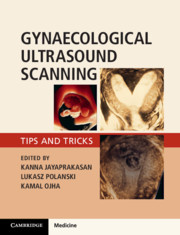Book contents
- Gynaecological Ultrasound Scanning
- Gynaecological Ultrasound Scanning
- Copyright page
- Contents
- Contributors
- Chapter 1 Get to Know Your Machine and Scanning Environment
- Chapter 2 Baseline Sonographic Assessment of the Female Pelvis
- Chapter 3 Difficult Gynaecological Ultrasound Examination
- Chapter 4 Sonographic Assessment of Uterine Fibroids and Adenomyosis
- Chapter 5 Sonographic Assessment of Congenital Uterine Anomalies
- Chapter 6 Sonographic Assessment of Endometrial Pathology
- Chapter 7 Sonographic Assessment of Polycystic Ovaries
- Chapter 8 Sonographic Assessment of Ovarian Cysts and Masses
- Chapter 9 Sonographic Assessment of Pelvic Endometriosis
- Chapter 10 Sonographic Assessment of Fallopian Tubes and Tubal Pathologies
- Chapter 11 Role of Ultrasound in Assisted Reproductive Treatment
- Chapter 12 Operative Ultrasound in Gynaecology
- Chapter 13 Sonographic Assessment of Complications Related to Assisted Reproductive Techniques
- Chapter 14 Sonographic Assessment of Early Pregnancy
- Chapter 15 Tips and Tricks when Using Ultrasound in a Contraception Clinic
- Chapter 16 Doppler Ultrasound in Gynaecology
- Index
- References
Chapter 10 - Sonographic Assessment of Fallopian Tubes and Tubal Pathologies
Published online by Cambridge University Press: 28 February 2020
- Gynaecological Ultrasound Scanning
- Gynaecological Ultrasound Scanning
- Copyright page
- Contents
- Contributors
- Chapter 1 Get to Know Your Machine and Scanning Environment
- Chapter 2 Baseline Sonographic Assessment of the Female Pelvis
- Chapter 3 Difficult Gynaecological Ultrasound Examination
- Chapter 4 Sonographic Assessment of Uterine Fibroids and Adenomyosis
- Chapter 5 Sonographic Assessment of Congenital Uterine Anomalies
- Chapter 6 Sonographic Assessment of Endometrial Pathology
- Chapter 7 Sonographic Assessment of Polycystic Ovaries
- Chapter 8 Sonographic Assessment of Ovarian Cysts and Masses
- Chapter 9 Sonographic Assessment of Pelvic Endometriosis
- Chapter 10 Sonographic Assessment of Fallopian Tubes and Tubal Pathologies
- Chapter 11 Role of Ultrasound in Assisted Reproductive Treatment
- Chapter 12 Operative Ultrasound in Gynaecology
- Chapter 13 Sonographic Assessment of Complications Related to Assisted Reproductive Techniques
- Chapter 14 Sonographic Assessment of Early Pregnancy
- Chapter 15 Tips and Tricks when Using Ultrasound in a Contraception Clinic
- Chapter 16 Doppler Ultrasound in Gynaecology
- Index
- References
Summary
While the uterus, cervix and ovaries can be well assessed by transvaginal ultrasound, normal fallopian tubes are not visible on ultrasound. Therefore, evaluation of the fallopian tubes needs special consideration. Tubal disease accounts for a significant proportion of female infertility and pelvic pain . The fallopian tubes may be damaged, most commonly due to pelvic inflammatory disease (PID), but endometriosis, previous pelvic surgery, fibroids, and pelvic tuberculosis may also be seen as frequent causes for tubal damage . Prior uterine surgeries like surgical or medical termination of pregnancy and myomectomy may predispose to subclinical inflammation or infection leading to tubal damage. Tubal patency may also be affected due to polyps, myomas or salpingitis isthmica nodosa, though the latter is not very commonly seen and not very confidently diagnosed on ultrasound.
- Type
- Chapter
- Information
- Gynaecological Ultrasound ScanningTips and Tricks, pp. 127 - 144Publisher: Cambridge University PressPrint publication year: 2020
References
- 1
- Cited by

